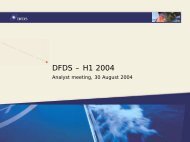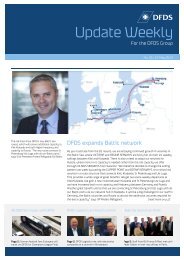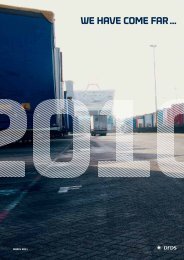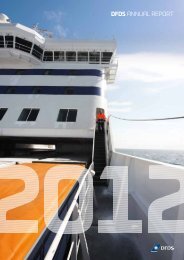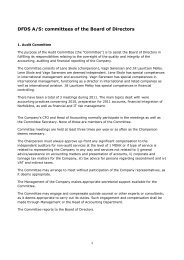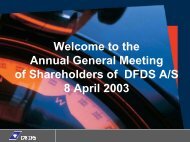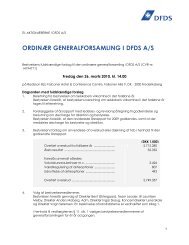English - DFDS
English - DFDS
English - DFDS
Create successful ePaper yourself
Turn your PDF publications into a flip-book with our unique Google optimized e-Paper software.
106 NOTEs<br />
<strong>DFDS</strong> annual report 2009<br />
>>> Note 39 continued<br />
The net realisable value for the Group’s most important assets, ships, is estimated based on the average of various independent broker assessments. The brokers’ assignment<br />
is to assess each ship in a “willing buyer – willing seller” situation. The assessments at 31 December 2009, as the assessments at 31 December 2008, are subject to<br />
higher uncertainty caused by the economical and financial situation for the world economy with few comparable transactions than if they were assessed in a normal and<br />
stable marked. Because the assessments have been obtained from different brokers the Group consider an average of these as the best and most valid estimate for the<br />
net realisable value for the ships. The Group collects independent broker assessments each year for the Group’s ships.<br />
Discount rate<br />
The Group determines a discount rate for each cash generating unit (business area) based on the interest rate (without risk) with addition of a risk premium attached<br />
to the individual business area. The interest rate (without risk) is determined to a 10 year Danish interest rate (without risk) at the end of the year. The risk premium is<br />
calculated as a general risk premium of the share market of 5% multiplied with the non-leveraged beta value for each cash generating unit.<br />
The non-leveraged beta values are calculated by gathering non-leveraged beta values for peer-group companies through the data base of Bloomberg for each business<br />
area. The validity of the non-leveraged beta value for each peer-group company is evaluated, so the beta values with lowest validity are eliminated. In general only very<br />
few peer-group companies exist as the beta values are only calculated for listed companies. As a result of this the non-leveraged beta values for the business areas Ro-Ro<br />
Shipping, Container Shipping, Terminal Services and Trailer Services are calculated together as a median of each peer-group company. In addition the four business areas are<br />
considered to be very comparable and are influenced by the same social conditions. For these four business areas the non-leveraged beta value is thus calculated of 0.87<br />
(2008: 0.86).<br />
For Passenger Shipping the non-leveraged beta value is calculated to 0.67 (2008: 0.61). The beta value is lower than for the other business areas, as the activity in Passenger<br />
Shipping is less sensitive to the general market development than the four other business areas.<br />
Finally the calculated discount rates are evaluated and compared with discount rates determined by a few analysts who follow the share of <strong>DFDS</strong> A/S.<br />
Sensitivity analyses<br />
In connection with the impairment tests sensitivity analyses of the expected earnings are prepared annually testing relevant risk factors and scenarios which the Group can<br />
measure on a reliable basis.<br />
A calculation is also made on each cash generating unit determining the break-even point of the discounting rate, calculating which discount rate that would return a<br />
recoverable amount equal to the carrying amount.<br />
Sensitivity analysis are prepared by changing the estimates within probable outcomes. None of these calculations changes the below stated result of impairment tests carried<br />
out.<br />
Order of impairment<br />
In case an indication of impairment is identified, goodwill will be the first asset in line to be written down followed by the primary non-current intangible and tangible<br />
assets in the individual business areas. The impairments will be based on the book value of the assets unless the write-down results in a value less than the net realisable<br />
value of the asset, the value in use of the asset (if available) or zero.<br />
Calculation for 2009<br />
In general no growth is included in the prognosis period (2008: none, 2007: none). Provided that a growth of 0% upon the budget for 2010 does not result in a value in<br />
use that at least match the book value, the calculations are based on scenarios with positive growth. These growth rates are compared to IMF’s estimate (World Outlook<br />
Economic Database, October 2009) of growth in GDP (gross domestic product) (in real terms) for the countries, in which the cash generating unit is operating.<br />
In the projection after the prognosis period a growth of 0% (2008: 0%, 2007: 0%) is assumed for all routes in Passenger Shipping.<br />
Discount rates (before tax) for each business area are:<br />
2007 2008 2009<br />
Ro-Ro Shipping 8.1 % 7.6 % 8.0 %<br />
Container Shipping 7.9 % 7.6 % 8.0 %<br />
Passenger Shipping 8.9 % 6.4 % 7.0 %<br />
Terminal Services 8.2 % 7.6 % 8.0 %<br />
Trailer Services 8.8 % 7.6 % 8.0 %<br />
For two passenger ships the value in use is less than book value. The net realisable value for each ship – calculated as the average of the four broker assessments – exceed<br />
the book value. In the light of this there is no basis for impairment of any of these two passenger ships.<br />
The net realisable value of the passenger ship Queen of Scandinavia is lower than the book value. Therefore an impairment of DKK 53.0 million is made in 2009.<br />
The net realisable value of the ro-ro ship Tor Anglia, which is classified as an asset held for sale, is lower than the book value. Therefore an impairment of DKK 6.1 million is<br />
made in 2009.<br />
Based on the impairment tests carried out in 2009, no basis has been found for impairment of any of the rest of the areas. In 2008 the value in use of the customer portfolio<br />
in <strong>DFDS</strong> Container Line B.V. was less than the book value for which reason an impairment of DKK 38.0 million was carried out. In addition to this other non-current<br />
tangible assets was impaired for a value of DKK 4.4 million, since the value in use was less than the book value. In 2007 the impairment tests carried out showed no basis<br />
for impairments.<br />
Impairment test of investments in group enterprises and associates (Parent Company)<br />
Impairment tests are made for each investment in group enterprises and associates. Each group enterprise is considered to be the smallest cash generating unit.<br />
The estimated value in use of cash flows is based on management approved budgets for the coming financial year and a projection under the assumption of a growth rate<br />
of 0%. Estimate of future cash flows are adjusted for uncertainties based on historical results and take into account expectations of possible fluctuation of future cash flows.<br />
The Parent Company uses a discounting rate, which is determined for the individual group enterprise and associates according to which business area they belong. See<br />
above table for discount rates in use for 2007, 2008 and 2009.<br />
In 2009 no impairment is made in group enterprises. In 2008 an impairment on the investment in <strong>DFDS</strong> Container Line B.V. of DKK 75.0 million and impairment on one<br />
other group enterprise of DKK 3.7 million was carried out, as the calculated values in use was lower than the book values. In 2007 no impairment was made in group<br />
enterprises.<br />
In 2009 an impairment on the cost price of <strong>DFDS</strong> Container Line B.V, has been partly reversed (DKK 40 million) because the calculated value in use exceeds the book<br />
value. .



